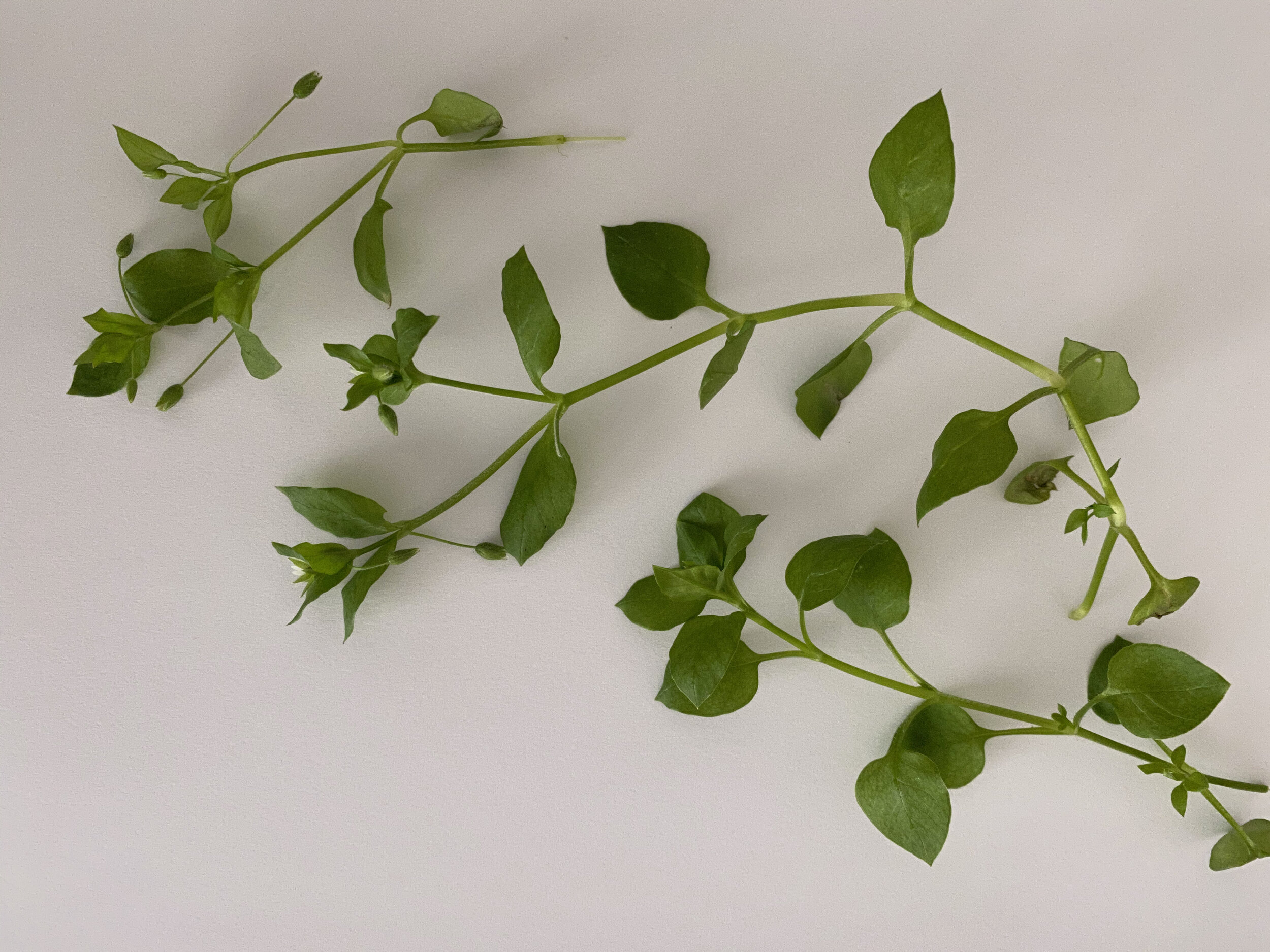Chickweed (Stellaria media) Mini Monograph
Chickweed (Stellaria media) – MINI MONOGRAPH
Family: Caryophyllaceae
Common Names: Mouse-ear, star chickweed, starweed, satinflower, starwort, stellaria and winterweed (Braun & Cohen 2015 p. 166).
Part Used: leaves, stems and flowers (Braun & Cohen 2015 p. 166).
Chickweed is an edible and medicinal herb. As the name suggests, it is loved by chickens (Grubb & Raser-Rowland 2019 p. 40) but also pigs and rabbits (Grieves 1992 p. 196).
“The Chickweed is also an instance of what is termed the ‘Sleep of Plants’, for every night the leaves approach each other, so that their upper surfaces fold over the tender buds of the new shoots, and the uppermost pair but one of the leaves at the end of the stalk are furnished with longer leafstalks than the others, so that they can close upon the terminating pair and protect the tip of the shoot”. – M. Greives, A Modern Herbal (1931).
Habitat: Grows in moist, rich soils in the cooler months and can usually be found popping up in veggie patches and pot plants. Full sun or partial shade (Grubb & Raser-Rowland 2019 p. 42-43).
Identification: Bright green in colour and grows in a low groundcover. Leaves are tear shaped. Look for a mohawk of small hairs along the stem in between nodes (Grubb & Raser-Rowland 2019 p. 42-43, Grieves 1992 p. 195). Often confused with Petty Surge (Euphorbia peplus), but be sure not to confuse them as Petty Surge should NOT be eaten, has a tinge of blue and contains a white sap that can be burn and irritate skin. Often used for warts. Avoid contact with the eyes (Grubb & Raser-Rowland 2019 p. 42-43).
Nutritional: Rich in protein, iron, vitamin A and C and antioxidants (Grubb & Raser-Rowland 2019 p. 42-43) and copper (Merika 2019, Braun & Cohen 2015 p. 166). Contains double the iron content of spinach (Grubb & Raser-Rowland 2019 p. 42-43).
Consumption: Chickweed, chopped finely, is great raw in sandwiches and salads and pairs well with nasturtium leaves and Dandelion petals (Grubb & Raser-Rowland 2019 p. 42-43, Grieves 1992 p. 196). Cooking will drastically reduce volume, as with spinach, and is great as a pesto (Grubb & Raser-Rowland 2019 p. 42-43).
Harvest: Using scissors chop the top 3-5cm, including flowers, aiming for more leaf and less stem, resulting in chickweed abundance as new shoots will grow and flourish (Grubb & Raser-Rowland 2019 p. 42-43).
Plant Spirit Qualities: “Chickweed clears heavy stagnant energy, entities or a heavy pain body caused by repetitive negative thoughts and emotions. It helps you to lighten up and be more positive. It is good for emotional release work or weight loss where overeating is caused by suppressed emotions. It is like a starlight that shines into the darkness trapped in your energy body, dissipating it and allowing you to feel light and positive once again. It is good for shifting depression, guild or shame.” – Heidi Merika, Wildcraft (2019).
Energetics: Cooling (Kew Royal Botanic Gardens 2016 p. 184). Planet – The Moon (Grieves 1992 p. 196).
Constituents: Saponins, Gamma-linolenic acid, phenols, flavonoids, beta carotene, mucilage, silica, coumarins, carboxylic acids (Merika 2019 p. 85, Braun & Cohen 2015 p. 167), sitosterols, polysaccharides and pentasaccharides (Braun & Cohen 2015 p. 167).
Saponins, may lower cholesterol, although toxic in extremely high doses (Grubb & Raser-Rowland 2019 p. 42-43).
Actions: Anti-rheumatic, vulnerary (wound healing), emollient (Hoffman 1990), demulcent, antitussive, expectorant, antimicrobial, antiviral and hepatoprotective (Braun & Cohen 2015 p. 167).
External Application: Crush the fresh plant, apply as a poultice or make into a gel or ointment (Grubb & Raser-Rowland 2019 p. 42-43) for inflamed skin – eczema, psoriasis (Merika 2019 p. 85).
Can be taken internally as a tincture, infusion, powder or fresh juice (succus) (Merika 2019 p. 86).
Caution: Allergic skin reactions can occur in some with topical application, patch testing on small area advised (Braun & Cohen 2015 p. 168).
References:
Braun, L. & Cohen, M. (2015). Herbs & Natural Supplements: An evidence-based guide (4rd ed. Vol 2.). NSW, Australia: Churchill Livingstone, Elsevier.
Grieves, M. (1992). A Modern Herbal. (3rd ed.). London, Great Britain: Tiger Books International.
Grubb, A. Raser-Rowland, A. (2019). The Weed Forager’s Handbook. Melbourne: Hyland House Publishing.
Hoffman, D. (1990). Holistic Herbal: A safe and Practical Guide to Making and Using Herbal Remedies. Great Britain: Thorsons
Kew Royal Botanic Gardens (2016). The Gardener’s Companion to Medicinal Plants: An A-Z of Healing Plants and Home Remedies. UK: Quarto Publishing.
Merika, H. (2019). Wildcraft: The science & spirit of wild plants as food & medicine. Eumundi, QLD Australia. Heidi Merika.

